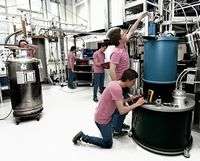Extreme machine is king of spin

At long last the first exciting research is starting to happen in an extraordinary machine in the UNSW School of Physics, with the installation of the world's largest cryogen-free vector magnet system.
Costing just under $1 million, the new Vector Field Facility (VFF) has been five years in the making but the wait has been well worthwhile: it is by any reckoning an awesome piece of equipment and will help to usher in a new age of advanced quantum electronic devices.
Electronic devices and materials underpin a trillion dollar industry worldwide and are an essential part of modern life, but the technology of the heart of all that activity - the transistor - has just about reached its technical limits.
The VFF will be an important tool for developing the quantum devices that will be at the heart of next-generation electronics, says ARC Professorial Fellow Alex Hamilton, of the School’s Condensed Matter Physics department. It will be officially opened today.
The VFF will be used by scientists and students to study devices ranging from advanced hole transistors and hole quantum dots, to self-assembled semiconductor nanowires. Requests are already coming in from international visitors wanting to use it.
“So far almost all semiconductor electronics use the fact that electrons have a negative charge. But there is great interest in spin-based electronics, which use the fact the electrons also have magnetic properties,” says Professor Hamilton.
“Spintronics uses magnetic fields to manipulate an electron’s spin to represent and process information. The first generation of spintronic devices is now standard technology for hard disk drives, boosting their storage capacity by roughly 20 times and allowing giant internet server farms to be built.
“The current challenge is to push the applications of spintronics beyond simply reading data and into the realm of true information processing, by incorporating more complex spintronic functionalities into semiconductor chips. But formidable challenges remain to be overcome.”
Developing spintronic devices relies on the ability to study how the electrical properties of materials and structures respond to the strength and orientation of externally applied magnetic fields. For that, researchers need low temperatures and the ability to apply magnetic fields in any direction - and that’s where the VFF comes in.
It can create a unique combination of extreme cold and powerful magnetic fields that can be oriented in any direction. Standing almost five metres tall and weighing more than half a tonne, the VFF can cool samples to temperatures as low as 0.01 degrees above absolute zero, has three superconducting magnets, stores a quarter of a MegaJoule of energy and generates tremendous forces.
“The force between the magnets when rotating the vector magnetic field can be enormous,” says Professor Hamilton. “Having three superconducting magnets operating simultaneously requires extreme engineering. The magnets all want to align, so the torque between them when two or more magnets are energised is huge: up to 45 tonne-cm - more than is generated by 15 formula-1 engines on the starting grid.”
Design work started in 2006 and bringing the project to fruition has involved extensive collaboration with researchers at other universities in Australia, Britain, Germany, the US, and New Zealand and Japan. Many technical, financial and even political challenges (notably a US strategic restriction) were overcome along the way.
Provided by University of New South Wales